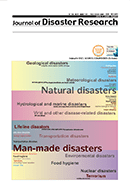
Journal of Disaster Research
Scope & Guideline
Connecting research and policy for enhanced disaster preparedness.
Introduction
Aims and Scopes
- Disaster Risk Reduction and Resilience Building:
The journal emphasizes strategies and methodologies aimed at minimizing disaster risks and enhancing community resilience through innovative approaches. - Impact of Climate Change on Disasters:
Research exploring the interplay between climate change and disaster frequency/intensity, including adaptation strategies for vulnerable regions. - Psychosocial Support and Community Recovery:
Studies addressing the mental health impacts of disasters and the importance of community support systems in recovery processes. - Technological Innovations in Disaster Management:
Focus on the use of emerging technologies, such as AI and simulations, in improving disaster preparedness and response. - Historical Analysis of Disasters:
Research that provides insights from historical disasters to inform current disaster management practices and policies. - Education and Awareness in Disaster Preparedness:
Development of educational programs and materials aimed at increasing public awareness and preparedness for disasters. - Public Health and Disaster Response:
Investigating the intersection of public health initiatives and disaster response, particularly in the context of pandemics and health emergencies.
Trending and Emerging
- Integration of Technology in Disaster Management:
A growing trend in the use of digital tools and data analytics for improving disaster response and recovery, including AI, simulations, and real-time monitoring. - Cross-Disciplinary Approaches:
Research that draws from various disciplines, including sociology, psychology, engineering, and environmental science, to foster a comprehensive understanding of disaster resilience. - Focus on Community Engagement and Local Knowledge:
Increasing emphasis on incorporating local knowledge and community participation in disaster preparedness and response strategies. - Mental Health and Psychosocial Support in Disasters:
Heightened focus on the mental health impacts of disasters and the importance of psychosocial support systems in recovery efforts. - Climate Change Adaptation Strategies:
Research addressing how communities can adapt to the increasing frequency and severity of climate-related disasters, emphasizing sustainability. - Public Health Preparedness in Disaster Contexts:
Emerging interest in the intersection of public health and disaster management, particularly in light of the COVID-19 pandemic and other health crises.
Declining or Waning
- Conventional Disaster Response Models:
Traditional models of disaster response that do not incorporate modern technological advancements or community-based approaches are becoming less prevalent. - Focus on Single Hazard Events:
There is a noticeable decline in research centered on single hazard events, as the journal increasingly addresses compound and interconnected risks. - Static Risk Assessment Methods:
Static methods of risk assessment are being overshadowed by dynamic and adaptive approaches that consider changing conditions and uncertainties. - Overemphasis on Infrastructure Solutions:
Research that primarily focuses on physical infrastructure improvements is waning in favor of more holistic, community-centric disaster resilience strategies. - Historical Case Studies without Current Application:
Historical analyses that do not connect lessons learned to contemporary disaster management practices are less frequently featured.
Similar Journals

Journal of Climate Change
Advancing knowledge for a sustainable future.The Journal of Climate Change, published by IOS PRESS, is a premier academic platform dedicated to the multidisciplinary investigation of climate change, its impacts, and mitigation strategies. With a focus on promoting innovative research, this journal aims to cultivate dialogue among researchers, policymakers, and environmental professionals globally. While the impact factor signifies its academic significance, the journal prides itself on providing unrestricted access to cutting-edge research insights, fostering collaboration within the scientific community. The journal’s ISSN is 2395-7611, and the E-ISSN is 2395-7697. Whether you are a seasoned researcher or a student exploring the critical implications of climate change, the Journal of Climate Change serves as an essential resource for the latest findings and discussions in this vital field.

Prehospital and Disaster Medicine
Connecting Research with Real-World Impact in DisastersPrehospital and Disaster Medicine is a leading peer-reviewed journal published by Cambridge University Press that targets the ever-evolving fields of emergency medicine and disaster management. With an ISSN of 1049-023X and an E-ISSN of 1945-1938, this journal has established its significance within the academic community since its inception, with coverage extending from 1985 to the present. It is widely recognized within its category as evidenced by its 2023 rankings, which position it in the Q2 quartile for both Emergency Medicine and Emergency Nursing. The journal boasts impressive Scopus rankings, standing at Rank #7/32 in Emergency Nursing and Rank #31/109 in Emergency Medicine, demonstrating its relevance and impact in these critical areas. Although it does not offer Open Access, Prehospital and Disaster Medicine is committed to disseminating vital research and innovative practices that address prehospital care, disaster response, and the intersection of these fields, serving as an essential resource for researchers, professionals, and students alike.
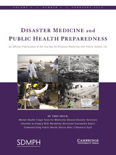
Disaster Medicine and Public Health Preparedness
Empowering research for resilient health systems.Disaster Medicine and Public Health Preparedness is a pivotal journal published by Cambridge University Press, dedicated to advancing the field of disaster medicine and public health. With an ISSN of 1935-7893 and an E-ISSN of 1938-744X, this journal holds a commendable place in the academic discourse, featuring a 2023 Scopus ranking of #221 out of 665 in the category of Public Health, Environmental and Occupational Health, placing it in the 66th percentile. It enjoys a Q2 quartile ranking, which underscores its significant contributions to the field. The journal, spanning from 2007 to 2024, serves as a critical platform for researchers, professionals, and students aiming to share innovative findings and best practices in preparing for and responding to public health emergencies. Though not available as Open Access, its rigorous peer-review process ensures high-quality publications that are relevant in addressing contemporary challenges in disaster preparedness. Operating out of the UK, specifically from Edinburgh Building, Shaftesbury Rd, Cambridge, this journal plays an integral role in policy formulation and educational efforts in public health, making it an essential resource for scholars intending to impact the sector meaningfully.

Disaster Prevention and Management
Fostering collaboration to mitigate disaster risks.Disaster Prevention and Management, published by Emerald Group Publishing Ltd, is a leading journal in the fields of disaster management, public health, and environmental policy. With an ISSN of 0965-3562 and an E-ISSN of 1758-6100, this journal has made significant contributions to both theoretical and practical advancements since its inception in 1992. Operating from the United Kingdom, it holds a Q2 ranking across various categories, including Business, Management and Accounting, Health (Social Science), and Public Health, reflecting its pivotal role in academic discourse and policy formulation. By engaging with contemporary issues related to disaster risk reduction, emergency preparedness, and resilience strategies, Disaster Prevention and Management aims to foster a multidisciplinary approach, making it a vital resource for researchers, practitioners, and students seeking to navigate the complexities of disaster scenarios effectively. With an impressive Scopus ranking across multiple categories, researchers are encouraged to explore its diverse range of articles and reports available for their academic and professional endeavors.
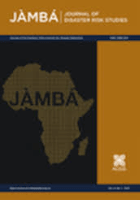
Jamba-Journal of Disaster Risk Studies
Innovative Research for Effective Risk Management.Jamba-Journal of Disaster Risk Studies, published by AOSIS, serves as a vital resource in the fields of management, monitoring, policy, law, and safety research, with an ISSN of 1996-1421 and an E-ISSN of 2072-845X. Since its establishment as an Open Access journal in 2006, Jamba has dedicated itself to disseminating high-quality research that informs and enhances disaster risk management practices, particularly within the South African context and beyond. With a robust Impact Factor and acknowledgement in the Q2 and Q3 quartiles across critical categories in 2023, Jamba ranks favorably in Scopus, notably Rank #50/109 in Social Sciences (Safety Research) and Rank #218/399 in Environmental Science (Management, Monitoring, Policy and Law). The journal's convergence over the years—from 2013 to 2024—signals its commitment to adapting contemporary challenges in disaster risk studies. Scholars and practitioners are encouraged to explore Jamba as a go-to platform for innovative insights and collaborative discussions that impact policy-making and practical applications in disaster risk reduction.
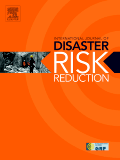
International Journal of Disaster Risk Reduction
Shaping best practices in disaster preparedness and governance.The International Journal of Disaster Risk Reduction is a leading academic publication dedicated to advancing the understanding and management of disaster risks, promoting innovative solutions and effective strategies for risk reduction. Published by ELSEVIER, this journal serves as a critical platform for researchers, professionals, and students in the fields of Geology, Geotechnical Engineering, and Safety Research. With an impressive impact factor and ranked in the top quartile (Q1) across its various categories as of 2023, it demonstrates exceptional quality and relevance in its contributions to science and engineering disciplines. The journal has been committed to disseminating high-quality research since its inception in 2012 and remains open for new submissions through 2024. The Scopus rankings reflect its prestigious position, with notable placements in Earth and Planetary Sciences and Social Sciences, highlighting its influence in shaping best practices for disaster risk governance. As an essential resource for anyone involved in disaster preparedness and mitigation, the International Journal of Disaster Risk Reduction fosters knowledge exchange and collaboration among stakeholders in the global community.
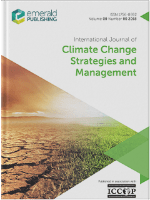
International Journal of Climate Change Strategies and Management
Transforming knowledge into actionable climate strategies.Introducing the International Journal of Climate Change Strategies and Management, a premier publication dedicated to advancing the understanding and development of innovative strategies addressing climate change. Published by Emerald Group Publishing Ltd in the United Kingdom, this journal has established itself as a trusted source within the realms of development, geography, and environmental science. With an impressive 2023 impact factor reflecting its high citation rates and a Q1 classification in pivotal categories such as Development and Geography, the journal stands at the forefront of climate change discourse. Since adopting an Open Access model in 2018, it has broadened its reach, making cutting-edge research accessible to a global audience. The journal encompasses a wide array of topics essential for academics and practitioners alike, focusing on management, policy-making, and methods for effective monitoring of environmental strategies. By fostering interdisciplinary dialogue, the International Journal of Climate Change Strategies and Management is essential for those aiming to contribute to sustainable solutions in our rapidly changing world.
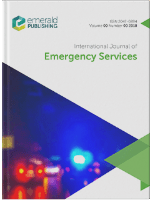
International Journal of Emergency Services
Bridging research and practice in emergency services.The International Journal of Emergency Services, published by Emerald Group Publishing Ltd, is a pivotal resource in the fields of management science, operations research, and safety research. With its ISSN 2047-0894 and E-ISSN 2047-0908, this journal serves as a platform for innovative research and discourse from 2012 through to 2024. Recognized for its quality, it holds a Q3 ranking in both management and safety categories, demonstrating its commitment to advancing knowledge and practice in emergency services. The journal is particularly valued for its contributions to enhancing operational efficiency, promoting safety, and addressing the evolving challenges faced by emergency service professionals globally. It attracts a diverse readership comprising researchers, practitioners, and students keen to explore cutting-edge findings and methodologies. With access options tailored for academic and professional communities, the International Journal of Emergency Services remains an essential reference for those seeking to improve emergency response frameworks and strategies within the UK and beyond.
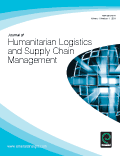
Journal of Humanitarian Logistics and Supply Chain Management
Empowering supply chains for effective disaster response.Journal of Humanitarian Logistics and Supply Chain Management is a premier academic journal published by Emerald Group Publishing Ltd that addresses the critical intersection of logistics and supply chain management within humanitarian contexts. With an ISSN of 2042-6747 and an E-ISSN of 2042-6755, this journal has established itself as a leading resource for researchers, professionals, and students dedicated to enhancing operational efficiency and effectiveness in disaster relief and humanitarian aid. The journal enjoys a distinguished standing with a Q1 ranking in Management Information Systems and a Q2 ranking in Management Science and Operations Research, reflecting its contributions to the field and its significant impact factor, placing it in the 75th percentile among its peers in Scopus rankings. Covering a spectrum of topics from innovative supply chain strategies to responsive logistics frameworks, the Journal of Humanitarian Logistics and Supply Chain Management provides valuable insights and practical solutions that are essential for enhancing resilience and responsiveness in humanitarian operations as it converges through the years from 2011 to 2024. Researchers and industry practitioners alike are encouraged to engage with its robust articles, fostering collaboration and knowledge exchange to meet the evolving challenges faced in humanitarian logistics.
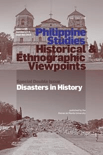
Philippine Studies-Historical and Ethnographic Viewpoints
Exploring the Depths of Philippine NarrativesPhilippine Studies-Historical and Ethnographic Viewpoints, published by Ateneo de Manila University, serves as a premier platform for scholarly discourse in the realms of history, cultural studies, and social sciences. With an ISSN of 2244-1093 and an E-ISSN of 2244-1638, this journal is committed to advancing the understanding of the Philippine experience through rigorous ethnographic and historical methodologies. Achieving notable category quartiles, including Q2 in History and Q3 in Cultural Studies, the journal's impact is evidenced by its strong Scopus rankings—placing it in the 85th percentile for Arts and Humanities (History). This connectivity fosters a rich environment for researchers, professionals, and students eager to explore the nuanced narratives of the Philippines. Although the journal is not currently Open Access, it remains an essential resource for those dedicated to the exploration of the complex socio-political and cultural tapestry of the region. With a publication timeline extending from 2012 to 2024, it continues to shape academic inquiry with great relevance and authority.